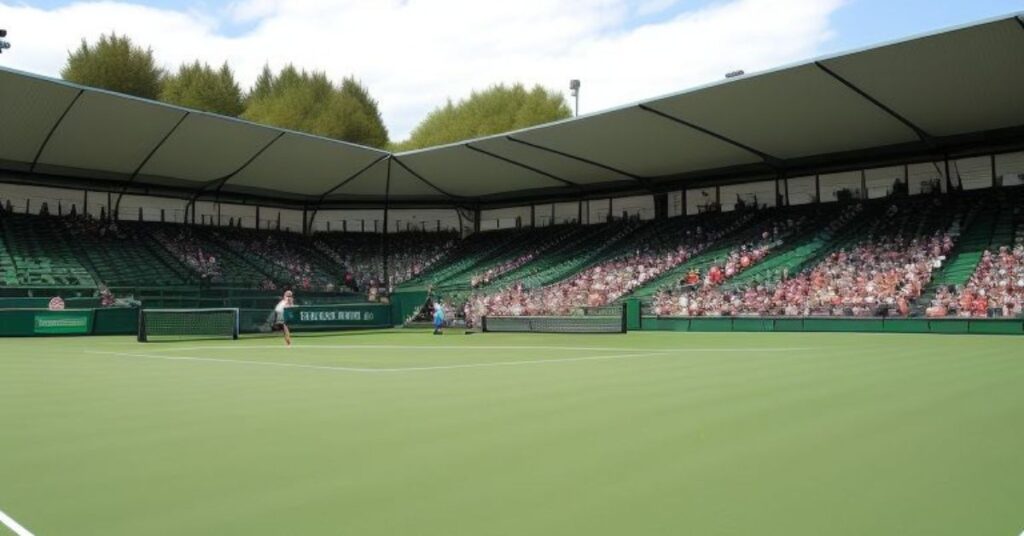Introduction to Is Tennis an Indoor or Outdoor Game?
Tennis is a versatile sport enjoyed by millions around the world, with the flexibility to be played in both indoor and outdoor environments. Each setting brings its own unique characteristics, influencing how the game is played and experienced. Whether it’s the controlled atmosphere of an indoor court or the ever-changing elements of outdoor play, these settings create distinct challenges and advantages for players.
In this blog, we’ll explore the key differences between indoor and outdoor tennis. From gameplay dynamics to strategic adjustments, we’ll dive into the benefits and challenges of both environments to help players make informed decisions based on their personal preferences and playing styles.

Understanding Tennis as an Indoor and Outdoor Game
Tennis is a sport that seamlessly transitions between indoor and outdoor settings, each offering a unique playing experience. Indoor courts provide a controlled, predictable environment, whereas outdoor courts expose players to natural elements like wind, sunlight, and varying temperatures. These factors not only impact the way the game is played but also influence a player’s overall strategy and performance. Whether you favor the consistency of indoor tennis or the adaptability required for outdoor play, the choice of setting can significantly shape your approach to the game.
Indoor Tennis
Characteristics of Indoor Tennis
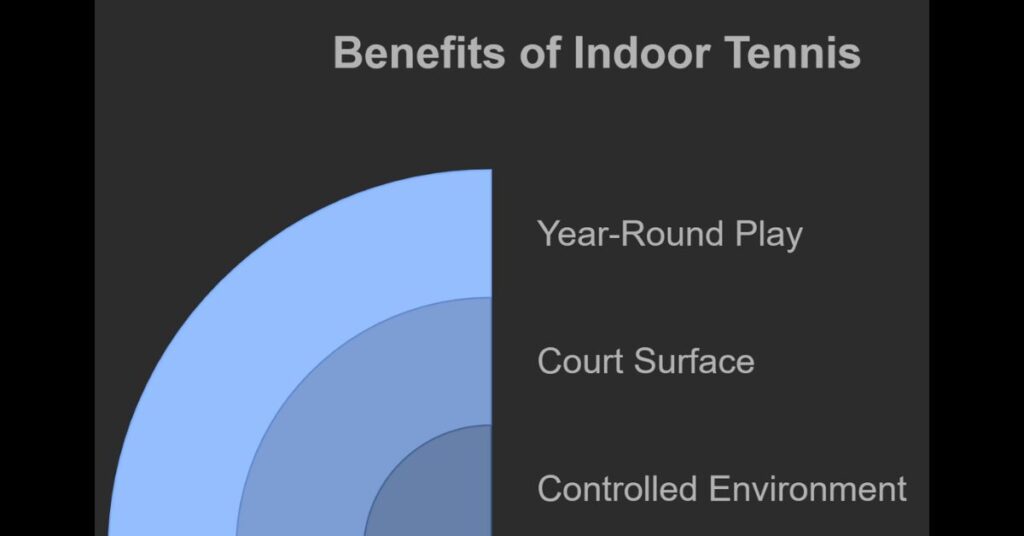
Controlled Environment
Indoor tennis courts offer a stable and predictable playing environment. Unlike outdoor courts, there’s no need to worry about weather disruptions such as wind, rain, or extreme temperatures. This ensures consistent ball behavior and bounce, allowing players to focus purely on their game without any external interference.
Court Surface
Indoor courts are typically flat, smooth, and well-maintained, often contributing to a faster-paced game. The absence of weather factors such as moisture or uneven surfaces enhances the speed of play and rewards aggressive, powerful styles. This also means fewer unpredictable bounces, allowing players to execute precise shots with confidence.
Year-Round Play
Indoor tennis facilities allow players to enjoy the sport all year long, irrespective of the season. Unlike outdoor venues that may close due to harsh weather conditions, indoor courts remain available, ensuring uninterrupted training or competition regardless of rain, snow, or heat.
Advantages of Indoor Tennis
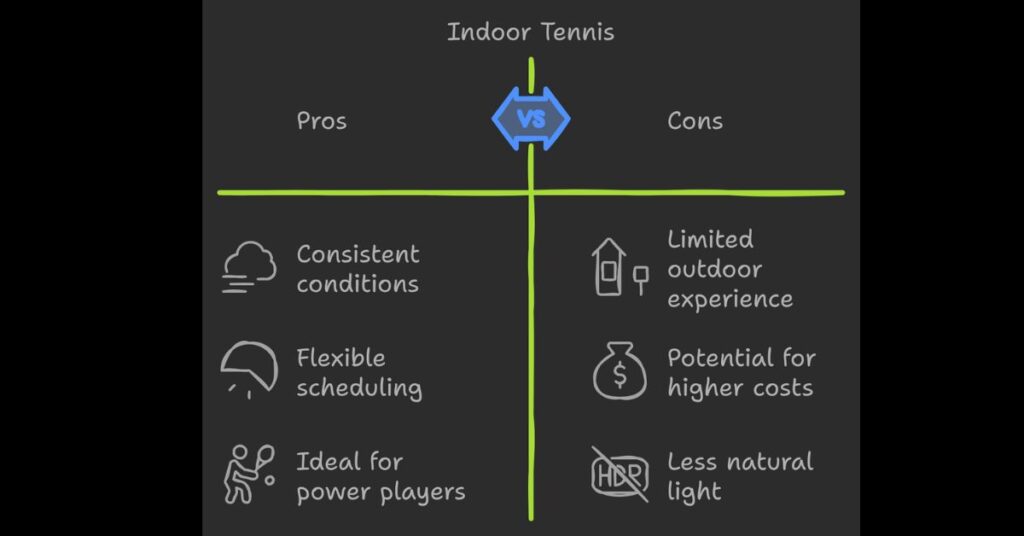
Predictability
One of the most significant advantages of indoor tennis is the consistency it offers. Without the unpredictability of weather, players can fine-tune their strategies and focus on technique without worrying about external factors affecting performance. This predictability helps players perfect their shot-making and gameplay execution.
Extended Play Hours
Many indoor tennis facilities operate with extended hours, making it easier for players to schedule their practice or matches. This flexibility accommodates players with busy lifestyles, allowing them to train or compete at their convenience.
Ideal for Power Players
The controlled environment of indoor courts benefits players who thrive on power and speed. The faster court surfaces and absence of wind make it easier to deliver precise, aggressive shots. This setting is particularly favorable for players who rely on quick serves, powerful groundstrokes, and fast-paced rallies to dominate their opponents.
Outdoor Tennis
Characteristics of Outdoor Tennis
Natural Elements:
Outdoor tennis introduces players to the unpredictable elements of nature. Wind, sunlight, and temperature fluctuations can all impact the behavior of the ball and the player’s performance. These factors require athletes to adapt their strategies in real time, making outdoor tennis as much a mental challenge as a physical one.

Surface Variation
Outdoor courts come in a variety of surfaces, including clay, grass, and hard courts. Each surface brings its own unique style of play: clay courts slow down the ball and favor players who use spin and endurance, while grass courts offer faster gameplay due to the low bounce. Hard courts strike a balance between speed and bounce, but the outdoor setting can still influence the ball’s movement.
Atmospheric Experience
Playing tennis outdoors provides a sense of connection with nature. The fresh air, sunlight, and changing surroundings create a dynamic environment that can enhance the sensory experience. This atmospheric variety makes outdoor tennis feel more immersive, contributing to the enjoyment of the game.
Challenges of Outdoor Tennis
Adaptability Required
Outdoor tennis demands a high level of adaptability from players. Wind can alter the trajectory of the ball, while changes in temperature can affect how the ball bounces or moves through the air. Players must constantly adjust their techniques, positioning, and shot selection based on the conditions, making outdoor tennis a test of flexibility and skill.
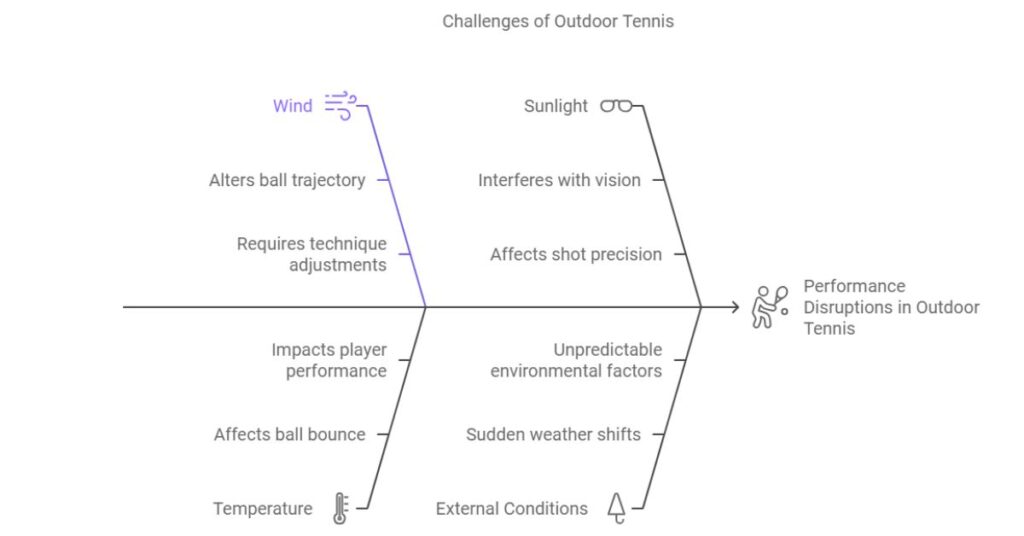
Potential Disruptions
External factors like sunlight and temperature shifts can pose additional challenges during matches. Sunlight may interfere with a player’s vision, particularly during high shots or serves, while sudden temperature changes can impact physical performance and shot precision. These disruptions require players to stay focused and continuously modify their approach throughout the match.
Comparing Indoor and Outdoor Tennis
Indoor and outdoor tennis each offer distinct gameplay experiences shaped by their respective environments. Indoor tennis provides a controlled atmosphere, where conditions are stable, predictable, and fast-paced. This allows players to focus solely on their strategy and execution without worrying about external elements. In contrast, outdoor tennis introduces natural variables such as wind, sunlight, and temperature changes, requiring players to constantly adapt their tactics and techniques.
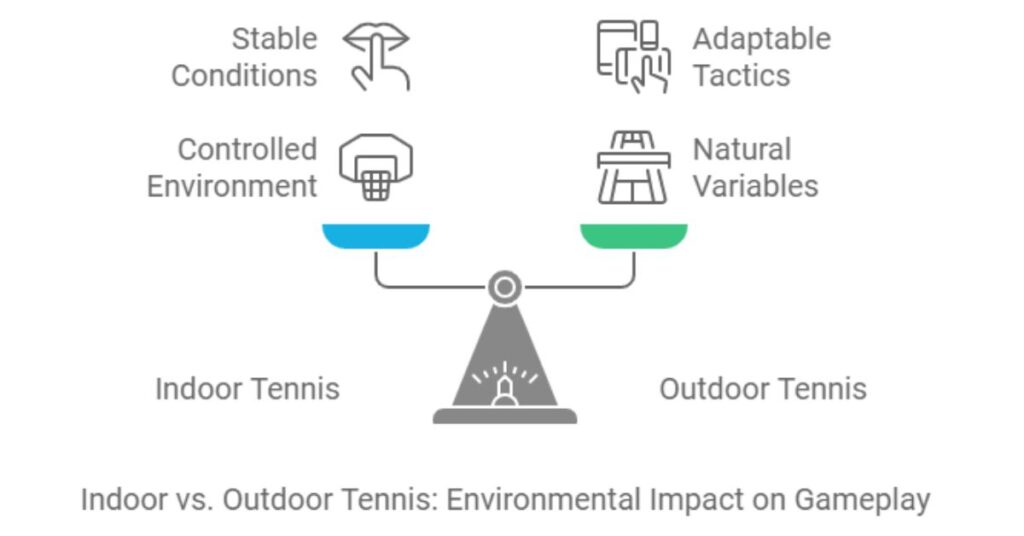
From a strategic perspective, indoor tennis often favors power players who thrive on speed and precision, as the fast surfaces and predictable conditions allow for aggressive play. Outdoor tennis, however, rewards players who are adaptable, patient, and skilled at managing varying conditions, such as adjusting for wind or handling different court surfaces like clay or grass.
When choosing between the two, players should consider their style of play. Those who prefer consistency and power might lean towards indoor tennis, while players who enjoy variety and are comfortable with unpredictability may prefer the challenges and dynamic experience of outdoor tennis.
Conclusion
Tennis is a versatile sport that can be played both indoors and outdoors, with each environment offering its own unique set of advantages and challenges. Indoor tennis provides a controlled, consistent atmosphere ideal for power players who thrive on speed and precision, while outdoor tennis introduces natural elements that test a player’s adaptability and strategic flexibility.
Ultimately, the choice between indoor and outdoor tennis depends on a player’s style, preferences, and how well they adjust to changing conditions. Whether you prefer the predictability of indoor courts or the dynamic experience of outdoor play, both settings offer rewarding experiences for tennis enthusiasts of all skill levels.
Frequently Asked Questions (FAQ) on Is Tennis an Indoor or Outdoor Game?
Can tennis be played both indoors and outdoors?
Yes, tennis can be played in both indoor and outdoor settings. Each environment offers different conditions that impact gameplay, with indoor tennis providing a controlled atmosphere and outdoor tennis involving natural elements like wind, sunlight, and varying court surfaces.
What are the main differences between indoor and outdoor tennis?
The key differences lie in the playing conditions. Indoor tennis offers consistent, predictable environments, making it ideal for players who prefer a faster pace and precision. Outdoor tennis, on the other hand, exposes players to weather conditions, requiring adaptability and strategic adjustments based on factors like wind and sunlight.
Which is better for beginners: indoor or outdoor tennis?
For beginners, indoor tennis can be more favorable due to the predictable conditions and consistent court surface. This allows new players to focus on developing their skills without the added challenge of adjusting to outdoor variables like wind and weather
How does weather affect outdoor tennis?
Weather plays a significant role in outdoor tennis. Wind can change the trajectory of the ball, while sunlight can create visibility challenges. Additionally, temperature fluctuations may impact the bounce of the ball and overall player performance, requiring adjustments in technique
Should I choose indoor or outdoor tennis based on my playing style?
Your playing style can help determine which environment suits you best. If you rely on power and precision, indoor tennis may be ideal due to its fast and consistent conditions. However, if you enjoy a more varied and strategic game, outdoor tennis with its natural elements might provide a more engaging experience.
